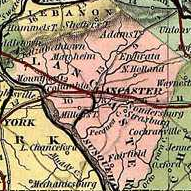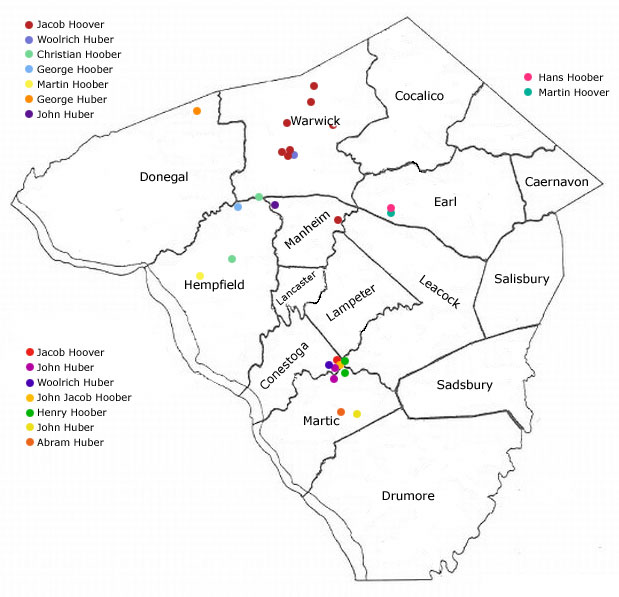I’ve recently discovered that George Hoover, son of Andrew and Catharine (___) Hoover, of Fayette County lived in Union Township his whole life. Therefore, he can not be the George Hoover who owned property in Westmoreland County from 1779 through 1799 and died in Armstrong County in 1813.
How Did We Get Here?
Before I get to what I’ve learned about Andrew Hoover’s son, George, let’s review. How did we previously determine that George Hoover of Armstrong County was the son of Andrew and Catharine (___) Hoover? What evidence led to that conclusion?
A biography of George’s grandson, Samuel Hoover of Indiana County, stated that:
“George Hoover, the grandfather of our subject, was among the early settlers of Westmoreland county. He was of German descent and came to that county when only fourteen years of age, with two brothers.”
Looking at Westmoreland County records reveals the baptisms of two children—Maria Magdalina and Solomon—to George and Eva Elisabeth (__) Hoover at Good Hope Lutheran and Reformed Church that match two heirs named in George Hoover’s estate papers.,, Children of George’s son Christian and daughters Catharina and Julianna were also baptized at Good Hope Lutheran and Reformed Church. The couple were also sponsors at their grandson Samuel’s baptism.
George Hoover purchased land in Donegal Township, Westmoreland County on 10 Apr 1779. Available county tax records put George there from 1783 through 1799 when he and Christian were marked as “gone from the county.”,, From these Armstrong and Westmoreland county records we know that the George Hoover in Westmoreland was, in fact, the same man as George Hoover of Armstrong County.
This George Hoover was in the Fayette/Westmoreland county area by 1779; but he could have been there earlier. From the 1800 U.S. census, we can estimate George’s birth date as circa 1755 or before. Going by Samuel’s biography, his grandfather, therefore, came to the Westmoreland area about 1769. Andrew Hoover’s son Jacob was in the Fayette County area by 1770 when he was living on land that today is part of Greene County, Pennsylvania. Andrew’s son Andrew Jr. was also in Fayette County early. He and his brother-in-law were of “Manallin Township and county aforesaid [Westmoreland]” when they purchased land from John Waller in 1775. We also know that Andrew Hoover had a son named George because he named him and left property to him in his last will & testament in 1784. George and wife Rosannah sold some of the land George inherited to John Hoover, presumably his brother.
So, it seems perfectly reasonable that George Hoover of Armstrong County was the son of Andrew Hoover of Fayette County. Right? Is this conclusion supported by the other facts we know or do they sow doubt?
In my page on Andrew Hoover Sr., I wrote:
“I find some of the birth dates of Andrew’s grandchildren to be problematic—their parents having to have become parents as teenagers.”
Several of George’s children are good examples. Based on census records, an estimated birth date for George’s first daughter Catharine (Hoover) Kern puts her birth ca 1760—1770. Her eldest son Solomon was born 30 Nov 1781, which is consistent with a birth in the early 1760s for Catharine. Census records for George’s second daughter Rosanna (Hoover) Waltenbaugh place her birth date bef 1765. Judging by these two children alone, a 1755 birth date for George is not feasible. While census records are known to be inconsistent and sometimes incorrect regarding age and “guesstimates” complicate the analysis, the likelihood of both of George’s daughters being at least 10 years off AND their children’s ages being off… You see where this is going. While it’s possible, there are significant problems to address.
Consider also that there are baptism records for both a Catharine and a Rosannah Hoover which place their births on 10 Apr 1761 and 27 Mar 1763. These dates fit perfectly with the estimated birth dates from the census records of George’s daughters. These church records name the girls’ parents as George and Eva Elisabeth Hoover.
But George’s wife was Rosannah. Right?
The only mention of Rosannah as George’s wife is in the deed where she and George sell land to John Hoover. How do we know this deed refers to the son of Andrew Hoover Sr.? Although this deed is difficult to read, you can make out the following:
“…And whereas the said Andrew Hoover Senior in and by his last will and testament dated the twenty-fifth day of May in the year of our Lord one thousand seven hundred and eighty four In the third section thereof did [?] [?] give unto his three sons Jacob Hoover [John] Hoover and George Hoover his whole estate… And whereas the said divisions have been [?] made and the [?] [?] [?] content? Now this indenture witnesseth the said George Hoover and Rosannah his wife do grant in consideration of the sum of sixty eight [pounds?] to them paid by John Hoover the receipt thereof to him by [?] [?] [?] granted bargained and sold – And by these presents do grant bargain & sell unto the said John Hoover his heirs [?] assigns the following described part of these [?] [?] of the lands of Andrew Hoover Senr divided unto the said George by the above in part [?] last will and testament of the said deceased…”
Louella Schaumberg Hoover believed that George and Rosannah sold the land (and executed the deed) prior to leaving for Armstrong County, but that the deed was only recorded when John sold the land in 1811. The next deed in the county deed book is for John Hoover’s sale of the land to James Fletcher. So, her assertion is a possibility.
Where did George and Rosannah live at the time of the deed? The deed provides no location information for George and Rosannah. If they were of Saltlick or Donegal townships, one would expect that information to be included in the deed. Because it is not, the evidence connecting this deed to the George Hoover of Westmoreland is slim. The logical presumption in this case is that George and Rosannah were of the same township and county as the land that they were selling—Union Township, Fayette County. Further proof of this assertion comes at the end of the deed where there is the following:
“Fayette County Pa—The [seventh?] day of November Anno Domini 1811 Before me [?] [?] one of the Justices of the Peace in and for the said County Personally came George Hoover and Rosannah his wife…”
This means that this George and Rosannah (___) Hoover were both alive and presumably living in Fayette County in 1811, most likely in Union Township. However, from the baptismal record of Maria Magdaline, daughter of George Hoover of Armstrong County, we know that George was married to Eva Elisabeth before 1787. We also know from deed, tax and census records that this couple had left the Westmoreland/Fayette County area by 1800.
Therefore, we must be dealing with two George Hoovers—one George of Fayette County, who was married to a woman named Rosannah and another George Hoover of Westmoreland and Armstrong counties, who was married to a woman named Eva Elisabeth. Furthermore, the deed records pertaining to the sale of land that Andrew Hoover left to his son George make it clear that the George Hoover of Fayette County, who married Rosannah, was the son of Andrew and Catharine (___) Hoover.
Look for more information on each of these men when I post their family group pages. In the meantime, if you have any questions, just drop me a line. And, as always, if you have more information, please shoot it my way…




